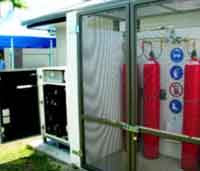Saturday 29/11/2008 Page: 6
 A house powered partly by fresh air, producing no greenhouse gas emissions, could become a reality in WA if a trial in Queensland is successful. Electricity company Ergon Energy is researching it using a display home at the Satterley Property Group's Smithfield Village Estate in Cairns. Satterley chief executive Nigel Satterley said it involved the use of a small hydrogen fuel-cell where compressed hydrogen gas was mixed with oxygen from the air to generate electricity.
A house powered partly by fresh air, producing no greenhouse gas emissions, could become a reality in WA if a trial in Queensland is successful. Electricity company Ergon Energy is researching it using a display home at the Satterley Property Group's Smithfield Village Estate in Cairns. Satterley chief executive Nigel Satterley said it involved the use of a small hydrogen fuel-cell where compressed hydrogen gas was mixed with oxygen from the air to generate electricity.Ergon Energy is putting more than $1 million into the research and development of the system, which uses a commercial fuel-cell product. According to Mr Satterley, the fuel-cell system will run for about two hours a day to demonstrate the supply of electricity to the house during peak times and determine how well its generation capability integrates with the mains electricity network. This is the prototype of the system and it's housed in a small shed. However, the researchers are working on ways to reduce its size to suit today's smaller blocks.
Ergon Energy spokeswoman Jenny Gannon said the system's ability to start up instantly was one of its benefits. It did not depend on sun or wind to generate power and was available on demand 24 hours a day. "If mains electricity supply is lost, the fuel-cell system can isolate from the mains network and supply sufficient power to maintain basic services, such as running a fridge and lighting," she said. If successful, the system would have the potential to help support an electricity network by reducing demand on the grid at peak times and delaying the need to build costly bigger and better powerlines and infrastructure.
Mr Satterley said the trial had far-reaching implications in WA where big distances made electricity supplies to remote areas more difficult, particularly at times of peak demand. He said it could also be the next "quantum leap" for the company's estates such as Evermore Heights in Baldivis, where environmentally important measures such as photovoltaic power generation cells and rainwater tanks were provided at no extra cost for buyers. At the estate, the company had also built an environmentally friendly home which slashed about 40 per cent off household power and 60 per cent off potable water usage.


